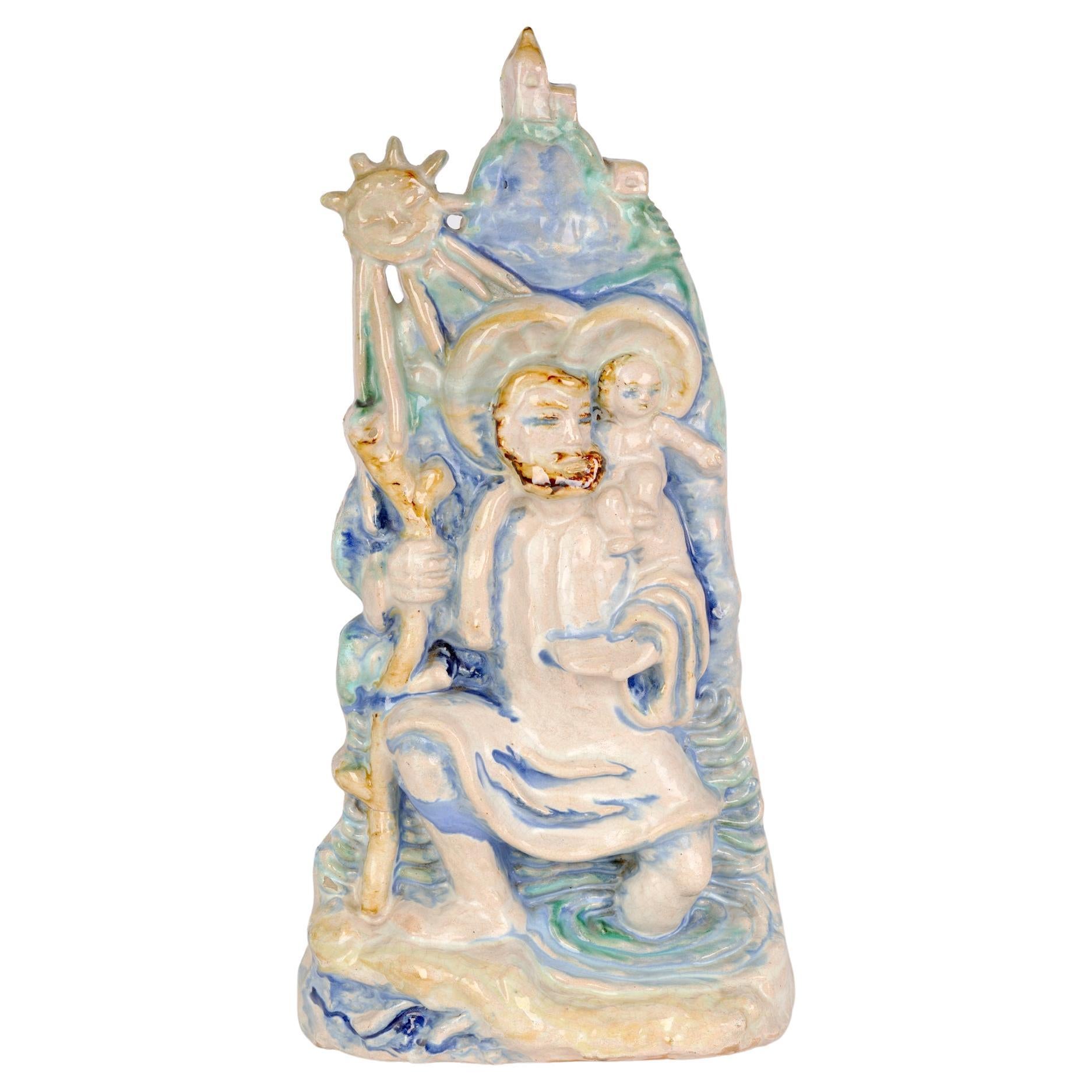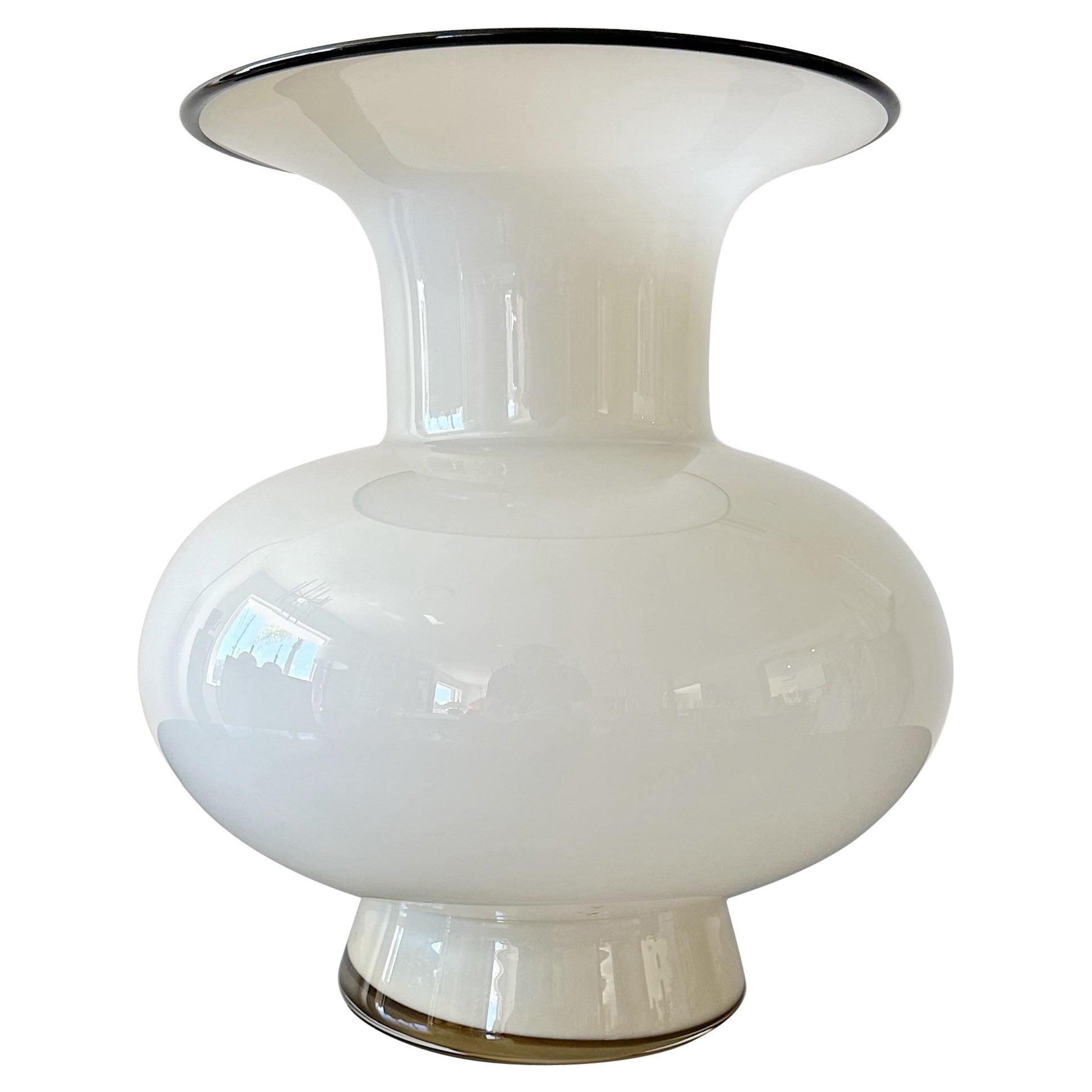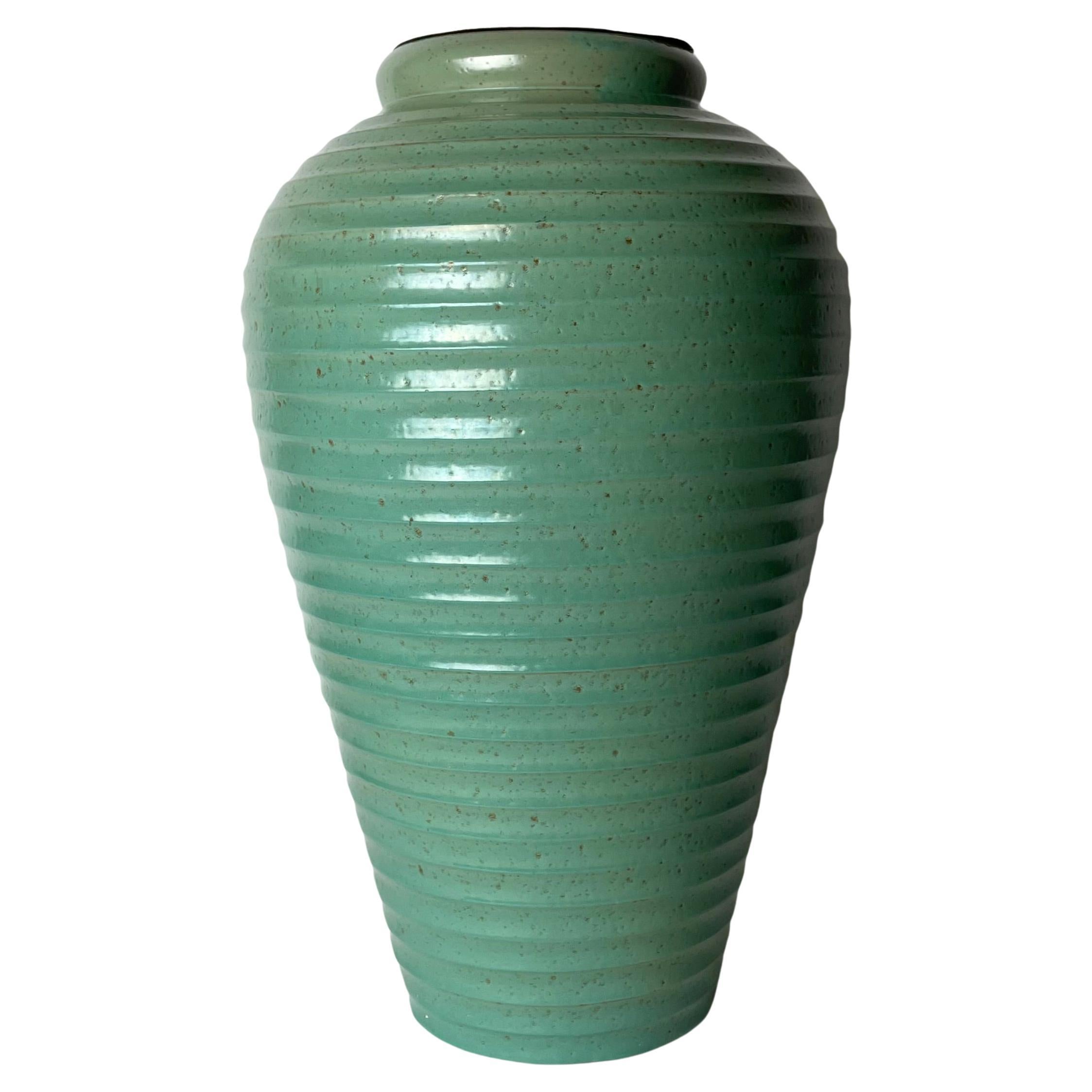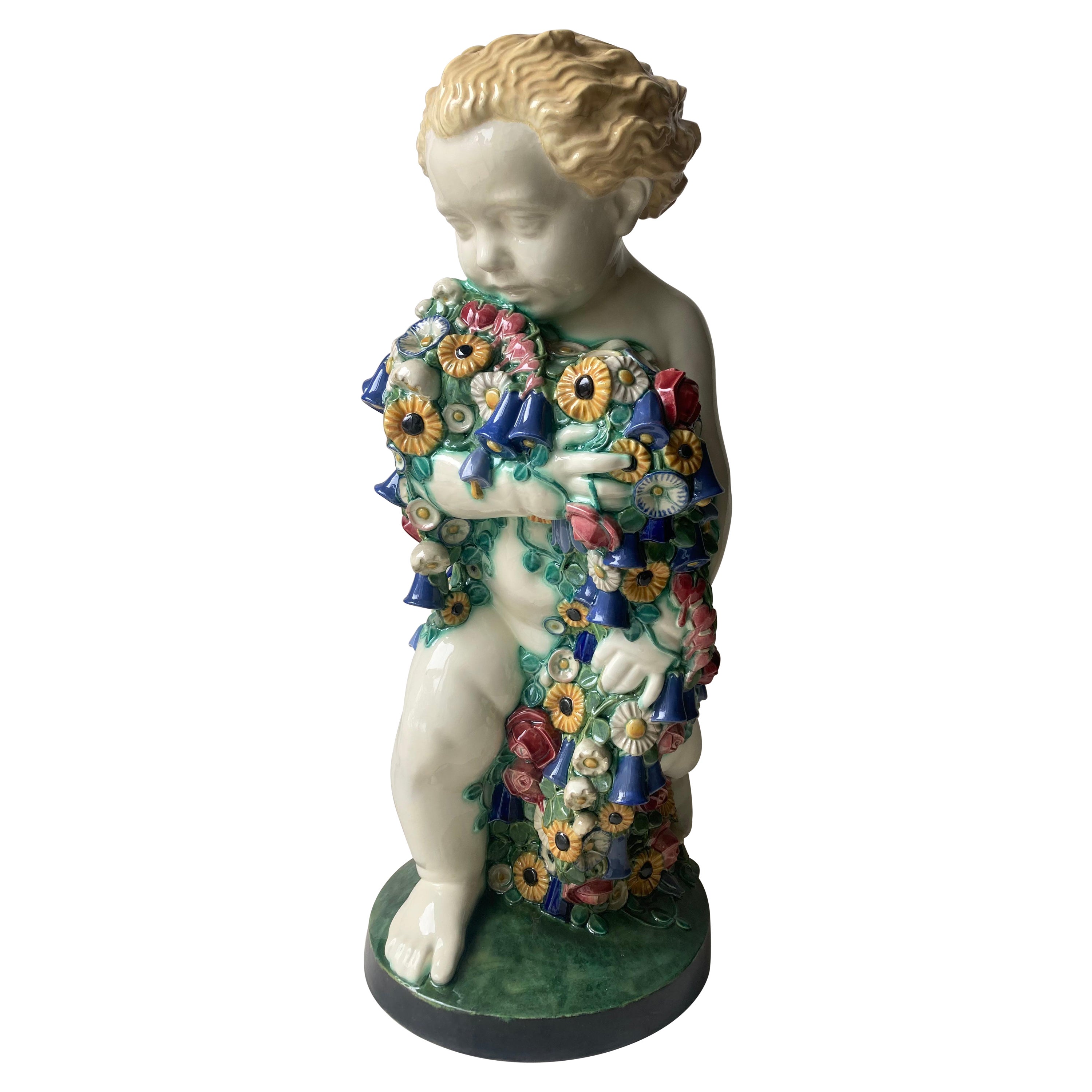Items Similar to Art Deco Floor Vase Attr to Michael Powolny Wiener Keramik Schleiss Gmunden
Want more images or videos?
Request additional images or videos from the seller
1 of 21
Art Deco Floor Vase Attr to Michael Powolny Wiener Keramik Schleiss Gmunden
About the Item
Art Deco floor vase attr. to Michael Powolny / Wiener Keramik / Schleiss Keramik Gmunden
„Vereinigte Wiener und Gmundner Keramik und Gmundner Tonwarenfabrik Schleiss, Ges.m.b.H.“
height: 52cm - diameter: 32.5cm - diameter rim: 16.5cm - weight: 7.7 kg
From a noble estate in Linz / Austria - in amazing good condition
Michael Powolny
Michael Powolny (* 18. September 1871 in Judenburg, Österreich-Ungarn; † 4. Jänner 1954 in Wien) war ein österreichischer Keramikdesigner, Bildhauer und Medailleur.
Leben
Nach Abschluss einer Hafnerlehre besuchte Powolny von 1891 bis 1894 die Fachschule für Tonindustrie in Znaim,
daran anschließend von 1894 bis 1901 die Wiener Kunstgewerbeschule. 1906 gründete er gemeinsam mit Bertold Löffler die Wiener Keramik,
deren Vertrieb bereits nach etwa einem Jahr von der Wiener Werkstätte übernommen wurde. 1913 kam es zum Zusammenschluss der Wiener Keramik mit der Gmundner Keramik
(Vereinigte Wiener und Gmundner Keramik und Gmundner Tonwarenfabrik Schleiss Gesellschaft m. b. H.). Michael Powolny wirkte von 1909 bis 1936 als Lehrer an der
Kunstgewerbeschule. Seine Arbeiten, die ab 1929 dem Art déco zugeordnet werden können,[1] wurden auf zahlreichen internationalen Ausstellungen gezeigt und erzielen bei
Sammlern hohe Preise. Powolny wurde von Josef Hoffmann bei der Ausstattung des Cabaret Fledermaus und des Palais Stoclet sowie bei der Gestaltung mehrerer großer Villenbautenin Wien herangezogen.
Auch der Entwurf für die neue österreichische Ein- und Zwei-Schilling-Münze von 1946 bis 1952 stammt von Powolny.
Er stand 1944 in der Gottbegnadeten-Liste des Reichsministeriums für Volksaufklärung und Propaganda.
Anlässlich seines 80. Geburtstages wurde Powolny 1951 mit der Ehrenmedaille der Bundeshauptstadt Wien ausgezeichnet.
Powolny wurde in einem ehrenhalber gewidmeten Grab auf dem Wiener Zentralfriedhof bestattet.
1965 wurde im 22. Wiener Gemeindebezirk die Powolnygasse nach ihm benannt.
Gmundner Keramik – Schleiss Keramik
Die „Gmundner Keramik“, wie wir sie heute kennen, ging aus einem im Jahr 1903 von Leopold Schleiss unter dem Namen „Gmundner Thonwaren-Fabrik“ (anfangs Thonwaren mit „h“) errichteten Betrieb in Traunleiten, heute Keramikstraße Gmunden, hervor.
Schon im Jahre 1843 kauften die Eltern von Leopold Schleiss in Gmunden die „Hafnerhäuser am See“, heute Theatergasse 14 und 16, und übten dort ihr Hafnergewerbe aus.
1883 übernahm Leopold die gut gehende und deshalb bald an ihre räumlichen Grenzen stoßende Werkstätte. Dies führte zum Kauf eines Grundstückes im oberhalb von Gmunden gelegenen Traunleiten, auf dem 1903 eine neue Fabrikationsstätte errichtet wurde.
Leopolds Sohn Franz Schleiss II (geb. 1884) zeigte großes handwerkliches und künstlerisches Talent und entwickelte sich zum überzeugten Vertreter der um die Jahrhundertwende aufkommenden neuen Kunstströmungen. Bereits 1907 waren mehrere Künstler und Künstlerinnen für das Unternehmen tätig, und Fayencen wie Kleinplastiken wurden auf Ausstellungen gezeigt. Nach seiner 1909 erfolgten Verehelichung mit der akademischen Bildhauerin Emilie Simandl, gründete er mit ihr 1910 die „Keramische Werkstätte F. u. E. Schleiss, Gmunden“.
1913 kam es zum Zusammenschluss mit der „Wiener Keramik“. Der neue Firmenname lautete „Vereinigte Wiener und Gmundner Keramik und Gmundner Tonwarenfabrik Schleiss, Ges.m.b.H.“. Die Modelle der „Wiener Keramik“ von Powolny, Löffler und anderen Künstlern gehörten nun zum künstlerischen Bestand des Unternehmens.
Nach einer Zeit unglaublicher Vielfalt und Fülle an außergewöhnlichen Keramiken kam es mit Beginn des Ersten Weltkrieges, im Rahmen der am Anfang des Krieges herrschenden Hochstimmung, zu einer Sortiment Erweiterung mit „patriotischer Kunst“.
Bald aber machte sich das Fehlen von zum Kriegsdienst eingezogenen Arbeitskräften bemerkbar. Mit der Gründung einer „Lehrwerkstätte für Keramik, Schleiss Schule“ steuerte Franz Schleiss dagegen und holte auf diese Weise neue Mitarbeiter in die Firma.
Nach Kriegsende erzeugte er mit einigen Absolventen der Schule Unikatkeramiken, die in der „Gmundner Werkstätte, registrierte Genossenschaft m.b.H.“ erzeugt und gemeinsam mit der „Gmundner Keramik“ vertrieben wurden.
1923 wurde die „Gmundner Keramik“ in eine Aktiengesellschaft umgewandelt und firmierte nun unter „Gmundner Keramische Werkstätten A.-G.“. Meinungsverschiedenheiten führten 1926 zum Austritt des Ehepaares Schleiss, welches daraufhin die „Josefine Schleiss Gmundner Keramik“, die spätere „Schleiss Keramik“, und in Deutschland die „Münchner Werkstätte G.m.b.H.“ gründete.
In der Folge geriet die „Gmundner Keramik“ in finanzielle Schwierigkeiten und wurde vom Industriellen August Warchalowski übernommen.
1938 gelangte die „Gmundner Keramik“ unter nationalsozialistische Verwaltung, wurde danach von deutschen Staatsbürgern erworben und in der Folge als kriegswichtiger Betrieb eingestuft. Schlechter erging es der „Schleiss Keramik“, die als nicht kriegswichtiger Betrieb bald unter Rohstoffmangel zu leiden hatte.
Bemühungen von Franz Schleiss, nach dem Ende des Krieges „seine“ „Gmundner Keramik“ zurück zu kaufen, scheiterten. Zuerst unter kommissarischer Verwaltung stehend, wurde die Firma einem der deutschen Eigentümer zurückgegeben. Dank der Wiederaufbaujahre ging es beiden Gmundner Unternehmen wirtschaftlich gut: Der „Schleiss Keramik“ mit ihren künstlerischen Keramiken und einem zweiten Betrieb in Oberösterreich, der „Gmundner Keramik“ mit ihrem Gebrauchsgeschirr und der figuralen Keramik, wie Aktfiguren und „Neger“, wie sie in den damaligen Katalogen genannt wurden.
Die „Schleiss Keramik“ erhielt nach dem Tod von Franz Schleiss 1968 mit seinen Töchtern Grete und Gertrude neue Firmeninhaber.
Nach dem 1978 erfolgten Ableben Gretes, führte Gertrude Schleiss die Werkstatt bis zur Schließung im Jahre 1983 weiter.
Die „Gmundner Keramik“ geriet in den 1960er-Jahren in finanzielle Schwierigkeiten und wurde 1968 von Johannes (Fürst von) Hohenberg erworben. Nach einer Reihe erfolgreicher Jahre kam es erneut zu wirtschaftlichen Problemen. 1997 wurde das Unternehmen von Johannes (Graf von) Moy übernommen und 2011 an seinen Sohn Max weitergegeben.
- Attributed to:Michael Powolny (Artist)
- Dimensions:Height: 20.48 in (52 cm)Width: 12.8 in (32.5 cm)Depth: 12.8 in (32.5 cm)
- Style:Art Deco (Of the Period)
- Materials and Techniques:
- Place of Origin:
- Period:
- Date of Manufacture:1928-1938
- Condition:
- Seller Location:Kumhausen, DE
- Reference Number:1stDibs: LU8587234088922
About the Seller
5.0
Gold Seller
These expertly vetted sellers are highly rated and consistently exceed customer expectations.
1stDibs seller since 2023
9 sales on 1stDibs
Typical response time: 2 hours
- ShippingRetrieving quote...Ships From: Bodenkirchen , Germany
- Return PolicyA return for this item may be initiated within 10 days of delivery.
More From This SellerView All
- 1950s Studio Keramik floor Vase series GARDA Atelier Huber Roethe LandshutLocated in Kumhausen, DESTUDIO KERAMIK FLOOR VASE Atelier Herta Huber Roethe Landshut 1950s marked "HR" Manufacturer ATELIER HUBER ROETHE Design Period 1950 to 1959 Production Period 1950 to 1959 Count...Category
Vintage 1950s German Mid-Century Modern Vases
MaterialsPottery
- 1950s Studio Keramik floor Vase Atelier Huber Roethe Landshut 1959 with inletLocated in Kumhausen, DESTUDIO KERAMIK FLOOR VASE Atelier Herta Huber Roethe Landshut 1950s (it´s been created by an artist who has worked in their Atelier : marked "BR") Manufacturer ATELIER HUBER ROETHE...Category
Vintage 1950s German Mid-Century Modern Vases
MaterialsPottery
- a pair of 1950s Studio Keramik floor Vases Atelier Berta Huber Roethe LandshutLocated in Kumhausen, DEan amazing set of 2 STUDIO KERAMIK FLOOR VASES by Atelier Herta Huber Roethe Landshut 1950s Manufacturer HUBER ROETHE Design Period 1950 to 1959 Production Period 1950 to 1959 C...Category
Vintage 1950s German Mid-Century Modern Vases
MaterialsPottery
- German Studio Keramik Floor Vase archaic amphora 60s huge & heavy (51cms 11kg )Located in Kumhausen, DEBESPOKE HUGE & HEAVY STUDIO KERAMIK FLOOR VASE - ARCHAIC AMPHORA amazing blue/brown luster overglaze Manufacturer unknown Design Period 1968 to 1978 Production Period 1968 to 19...Category
Vintage 1970s German Arts and Crafts Vases
MaterialsPottery
- Art Nouveau Southern French Fayance art pottery FLOOR VASE rare colours&patternLocated in Kumhausen, DEA giving joy beautiful French Fayence Floor Vase fantastic Art Nouveau pattern - Impressing Colours Manufacturer unknown - marked Design Period 1915 - 1925 Country of Manufacture : France H / height: 46 cm ~ Gew. / weight: 4550 grs DM / diameter max: 28 cm ~ DM oben / diameter inner rim: 19.8 cm .... an ode to Southern France A Legend of Provence by Adelaide Anne Procter (30 October 1825 – 2 February 1864) The lights extinguished, by the hearth I leant, Half weary with a listless discontent. The flickering giant-shadows, gathering near, Closed round me with a dim and silent fear. All dull, all dark; save when the leaping flame, Glancing, lit up a Picture's ancient frame. Above the hearth it hung. Perhaps the night, My foolish tremors, or the gleaming light, Lent power to that Portrait dark and quaint, — A Portrait such as Rembrandt loved to paint, — The likeness of a Nun. I seemed to trace A world of sorrow in the patient face, In the thin hands folded across her breast: — Its own and the room's shadow hid the rest. I gazed and dreamed, and the dull embers stirred, Till an old legend that I once had heard Came back to me; linked to the mystic gloom Of that dark Picture in the ghostly room. In the far south, where clustering vines are hung; Where first the old chivalric lays were sung; Where earliest smiled that gracious child of France, Angel and knight and fairy, called Romance, I stood one day. The warm blue June was spread Upon the earth; blue summer overhead, Without a cloud to fleck its radiant glare, Without a breath to stir its sultry air. All still, all silent, save the sobbing rush Of rippling waves, that lapsed in silver hush Upon the beach; where, glittering towards the strand The purple Mediterranean kissed the land. All still, all peaceful; when a convent chime Broke on the mid-day silence for a time, Then trembling into quiet, seemed to cease, In deeper silence and more utter peace. So as I turned to gaze, where gleaming white, Half hid by shadowy trees from passers' sight, The Convent lay, one who had dwelt for long In that fair home of ancient tale and song, Who knew the story of each cave and hill, And every haunting fancy lingering still Within the land, spake thus to me, and told The Convent's treasured Legend, quaint and old: — Long years ago, a dense and flowering wood, Still more concealed where the white convent stood, Borne on its perfumed wings the title came: " Our Lady of the Hawthorns " is its name. Then did that bell, which still rings out to-day, Bid all the country rise, or eat, or pray. Before that convent shrine, the haughty knight Passed the lone vigil of his perilous fight; For humbler cottage strife or village brawl, The Abbess listened, prayed, and settled all. Young hearts that came, weighed down by love or wrong, Left her kind presence comforted and strong. Each passing pilgrim, and each beggar's right Was food, and rest, and shelter for the night. But, more than this, the Nuns could well impart The deepest mysteries of the healing art; Their store of herbs and simples was renowned, And held in wondering faith for miles around. Thus strife, love, sorrow, good and evil fate, Found help and blessing at the convent gate. Of all the nuns, no heart was half so light, No eyelids veiling glances half as bright, No step that glided with such noiseless feet, No face that looked so tender or so sweet, No voice that rose in choir so pure, so clear, No heart to all the others half so dear, So surely touched by others' pain or woe, (Guessing the grief her young life could not know,) No soul in childlike faith so undefiled, As Sister Angela's, the " Convent Child. " For thus they loved to call her. She had known No home, no love, no kindred, save their own. An orphan, to their tender nursing given, Child, plaything, pupil, now the Bride of Heaven And she it was who trimmed the lamp's red light That swung before the altar, day and night; Her hands it was whose patient skill could trace The finest broidery, weave the costliest lace; But most of all, her first and dearest care, The office she would never miss or share, Was every day to weave fresh garlands sweet, To place before the shrine at Mary's feet. Nature is bounteous in that region fair, For even winter has her blossoms there. Thus Angela loved to count each feast the best, By telling with what flowers the shrine was dressed. In pomp supreme the countless Roses passed, Battalion on battalion thronging fast, Each with a different banner, flaming bright, Damask, or striped, or crimson, pink, or white, Until they bowed before a newborn queen, And the pure virgin Lily rose serene. Though Angela always thought the Mother blest Must love the time of her own hawthorn best, Each evening through the years, with equal care, She placed her flowers; then kneeling down in prayer, As their faint perfume rose before the shrine, So rose her thoughts, as pure and as divine. She knelt until the shades grew dim without, Till one by one the altar lights...Category
Vintage 1910s French Art Nouveau Vases
MaterialsPottery
- traditional Italian art pottery floor vase floral midcentury classic white&blueLocated in Kumhausen, DEbeautiful Italian art pottery floor vase floral pattern Manufacturer unknown Design Period 1958 to 1968 Production Period 1958 to 1968 Country of Manufacture Italy H / height: ...Category
Vintage 1960s German Arts and Crafts Vases
MaterialsPottery
You May Also Like
- Wiener Werkstatte St Christopher Pottery Figure Attributed to Michael PowolnyBy Michael PowolnyLocated in Bishop's Stortford, HertfordshireAn unusual Austrian art pottery sculptural figure of St Christopher carrying the Christ child across a river attributed to renowned Austrian sculptor, Ceramist, designer and teacher Michael Powolny (Austrian, 1871-1954) and probably dating between 1920 and 1930. The hand-crafted figure shows St Christopher with the Christ child on his shoulder and a wooden staff...Category
Vintage 1920s Austrian Art Deco Figurative Sculptures
MaterialsStoneware
- Loetz Bohemiam Cream Large Vase by Michael Powolny, 1920sBy Michael PowolnyLocated in West Palm Beach, FLLoetz Bohemian vase crafted by Michael Powolny during the 1920s. This piece from the early 20th century showcases an exceptional size uncommon for Powolny. Adorned in a cream hue, ac...Category
Vintage 1920s Austrian Vienna Secession Vases
MaterialsGlass
- Crystal Vase Jugendstil Austria circa 1918 Michael Powolny Loetz for LobmeyrBy Michael Powolny, Loetz GlassLocated in Klosterneuburg, ATThis elegant object of the Loetz glassworks was produced immediately after the First World War, in the years 1918- 1919. Although stylistic as well as technical recourse to past tech...Category
Vintage 1910s Austrian Jugendstil Vases
MaterialsGlass, Blown Glass, Art Glass
- Bohemian Loetz Red Tango Glass Vase w. Black Accents by Michael PowolnyBy Loetz Glass, Michael PowolnyLocated in Bad Säckingen, DEThis antique Art Nouveau art glass vase by Michael Powolny for Loetz is an impressive and highly sought-after art piece from the early 20th cen...Category
Vintage 1910s Austrian Vienna Secession Vases
MaterialsGlass, Blown Glass, Art Glass
- Michael Powolny Ceramic Pottery Sculpture, Large Putto "Spring" Winer KeramikBy Wiener Keramik Werkstätte, Michael PowolnyLocated in Los Angeles, CABeautiful, ceramic / pottery Putto. "Figure of Spring" designed by Michael Powolny 1871-1954, made by Wiener Ceramic, marked with MP and WK as shown in picture. This is one of the la...Category
Early 20th Century Austrian Art Nouveau Figurative Sculptures
MaterialsCeramic
- Elegant 1930s Art Deco Floor Vase by Jerk Werkmäster, Nittsjö Keramik, SwedenBy Jerk Werkmaster, NittsjoLocated in Knivsta, SEElegant and large 1930s Art Deco Floor Vase by Jerk Werkmäster , Nittsjö Keramik, Sweden. Very period Art Deco design and with a beautiful color. The floor vase is made of glazed ear...Category
Vintage 1930s Swedish Art Deco Vases
MaterialsEarthenware





